NO! Absolutely not, especially for commuter cruisers. Originally we topped off both diesel tanks and added an additive before leaving the boat for six months. But the ONLY way to really eliminate annual fuel issues is to HAND CLEAN the fuel tanks before you leave the dock. Unfortunately, it’s not always possible ….
We have an algae-X filter (either voodoo or magic, depending on who you believe) and racor filters before the diesel, but trust me, the bottom of the fuel tanks are accumulating gunk that any fuel polishing system simply cannot eliminate completely. Don’t get me wrong, we love our fuel polishing system and use it regularly.
When we bought the boat in 2001, both diesel tanks desperately needed cleaning (it was already 16 years old). Since the center tank has horizontal baffles defeating any attempt to physically clean the bottom of the tank, we opted to have the tanks “steam cleaned” by a professional – once before we left Annapolis, which was apparently good enough to get us to Florida.

All went well for a year or two while we were still in the “pre-cruising” spend 50 nights a year aboard mode, until one day the diesel sputtered and died while we were motoring up the ICW with no wind. We quickly dropped the anchor off to the side of the ICW, and checked all the filters, all looked well. We cleaned the strainer and scratched our heads. Then we restarted the diesel, no problem and it ran for another hour or so and then the same thing happened.
When we returned to the marina, our diesel mechanic found a screen over the intake hose leading into the fuel tank. When fuel would suck up enough gunk, the screen would shut off the fuel flow to the diesel, causing it to die. After sitting at anchor for a few minutes, the gunk would work its way away from the screen and the diesel would start and run perfectly until it happened again.
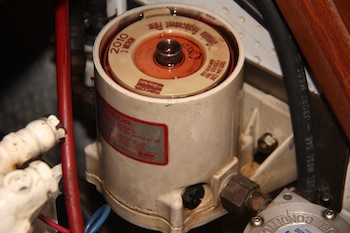 Our diesel mechanic advised removing the screen, but adding the fuel polishing system which consisted of an additional huge 2010 2 micron Racor filter and various hoses to allow us to polish the diesel in either tank and return it to the same tank OR polish the fuel in the center tank and return it to the starboard tank, which is our standard operating procedure. Diesel Don built our fuel polishing system himself and included a vacuum gauge to alert us when the filter needed replacing.
Our diesel mechanic advised removing the screen, but adding the fuel polishing system which consisted of an additional huge 2010 2 micron Racor filter and various hoses to allow us to polish the diesel in either tank and return it to the same tank OR polish the fuel in the center tank and return it to the starboard tank, which is our standard operating procedure. Diesel Don built our fuel polishing system himself and included a vacuum gauge to alert us when the filter needed replacing.
Luckily for the home team, we have two fuel tanks, the original in the bilge/keel and another under the back starboard bunk which takes up alot of potential storage space, but it adds 35 gallons of fuel to the boat allowing us to carry 70 gallons in tanks plus the jerry cans on deck. The starboard quarter fuel tank was installed WITH a usable inspection port.

Every year before our cruising season, we transfer the fuel from the starboard tank to the center tank (which we usually leave totally empty these days), then hand clean the starboard tank to remove ALL the gunk that has accumulated over the previous 12 months – six of which we’ve been gone, six of which we were cruising aboard. Then we polish the fuel once again as we filter it back into the starboard tank. We run the diesel from the starboard tank to try and keep clean fuel being fed to the engine.
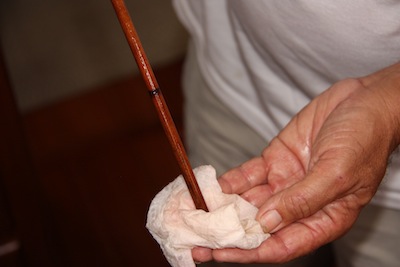
So that’s our solution, and other than the one time sailing the outer islands of Belize when we didn’t pay enough attention (our fuel gauge is a wooden dowel rod that we have to manually insert into the tank) to the fuel levels and the starboard tank ran out of fuel, we haven’t had (knock on teak) any diesel fuel related problems. 🙂
How do you make sure your diesel fuel stays clean … adding the complication of being commuter cruisers, it’s a challenge! Please leave a comment and share! Cheers! Jan

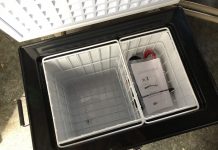








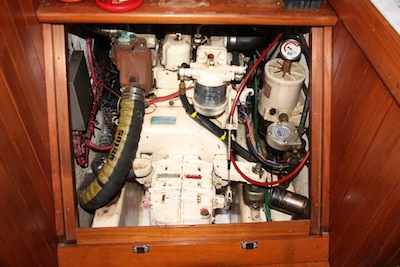
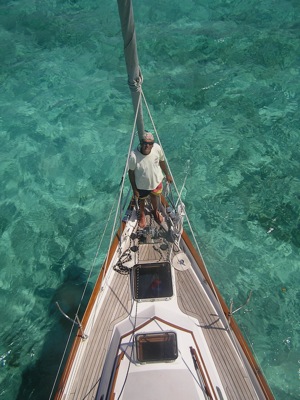
Polishing fuel from your center tank and pumping it to your starboard tank and running the engine off of it is a good system, Jan. I think your starboard tank is referred to as a “day tank”. My old trawler carries 800 gallons of diesel and running off a day tank wasn’t practical for us. When I installed our two Filter Bosses for our two engines, I put each pickup tube about three inches above the bottom of the tank. When I installed our fuel polishing system, I put that pickup tube about a half inch above the bottom of the tank where it will pick up gunk and water long before it gets to the Filter Bosses’ pickups.
I looked at fuel polishing systems at the Annapolis Boat Show and decided I could make my own for much less. All you need is a dedicated Racor filter, an inexpensive electric fuel pump from Autozone, a copper pipe for a pickup tube, and some fuel lines to connect it all together. It was cheap and easy to install, especially because I already had the Racor and fuel pump.
I wouldn’t own a boat without one. A fuel polishing system should be standard equipment on all boats.
Here in the UK due to EU regulations restricting our diesel usage to pretty naff fuel susceptible to diesel bug, is it worth attempting a new solution to maintaining fuel in good condition.
All diesel engines include a recirculation system including a pump. Would it not be worthwhile considering drawing fuel from the very bottom of the tank, separate out the water and diesel bug gunk, filter it, and then pass it to the engine for consumption and/or recirculation back to the tank.
Anyone any thoughts on this?
Maybe you need better diesel additives